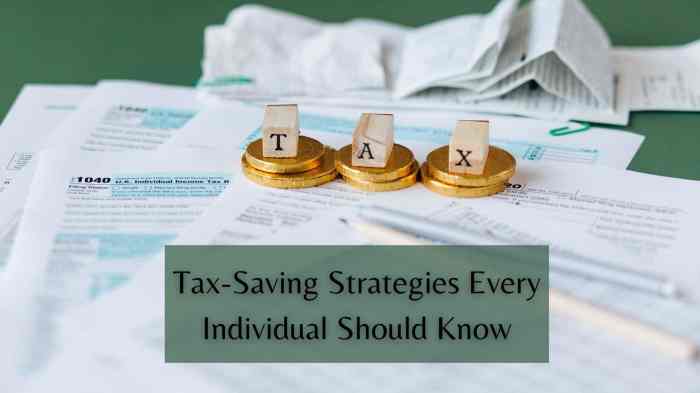Get ready to dive into the world of tax-saving strategies where we break down the key elements for individuals and businesses. This is your ultimate guide to keeping more of your hard-earned cash in your pocket.
Overview of Tax-Saving Strategies
Tax-saving strategies are crucial for both individuals and businesses as they help in reducing tax liabilities and maximizing savings. By taking advantage of various tax-saving opportunities, individuals and businesses can retain more of their hard-earned money.
Different Types of Tax-Saving Strategies
- Utilizing tax-deferred retirement accounts such as 401(k) or IRA to save for retirement while reducing taxable income.
- Claiming tax deductions for expenses like mortgage interest, charitable contributions, and medical expenses.
- Utilizing tax credits such as the Child Tax Credit, Earned Income Tax Credit, and education credits to reduce tax liability directly.
- Strategically planning investments to minimize capital gains taxes.
Benefits of Implementing Tax-Saving Strategies
- Increased savings: By reducing tax liabilities, individuals and businesses can save more money for future goals or investments.
- Financial security: Implementing tax-saving strategies can provide a cushion for unexpected expenses and emergencies.
- Improved cash flow: By minimizing tax payments, individuals and businesses can have more cash on hand for day-to-day expenses or growth opportunities.
Individual Tax-Saving Strategies
Saving on taxes as an individual can be crucial for your financial well-being. There are several strategies you can implement to reduce your tax liability and keep more money in your pocket.
Tax Deductions for Individuals
One way individuals can save on taxes is by taking advantage of tax deductions. These deductions reduce your taxable income, which in turn lowers the amount of taxes you owe. Some common tax deductions include:
- Charitable contributions
- Mortgage interest
- Medical expenses
- Educational expenses
Tax-Deferred Retirement Accounts
Another effective strategy for saving on taxes is contributing to tax-deferred retirement accounts such as a 401(k) or Traditional IRA. By contributing to these accounts, you can lower your taxable income for the year and defer paying taxes on the money until you withdraw it in retirement.
Impact of Tax Credits
Tax credits are another way individuals can reduce their tax liability. Unlike deductions that reduce taxable income, tax credits directly reduce the amount of taxes you owe. Common tax credits include the Child Tax Credit, Earned Income Tax Credit, and Education Tax Credits. These credits can significantly lower your tax bill, so it’s essential to take advantage of them if you qualify.
Business Tax-Saving Strategies

When it comes to business tax-saving strategies, there are several ways that businesses can benefit from tax deductions related to expenses. These strategies can help reduce the tax burden on business entities, allowing them to keep more of their hard-earned money.
Maximizing Tax Deductions
One of the key ways that businesses can save on taxes is by taking advantage of tax deductions related to business expenses. By carefully tracking and documenting expenses such as office supplies, travel costs, and employee salaries, businesses can reduce their taxable income, ultimately lowering the amount of tax they owe.
Advantages of Tax Planning
Tax planning is essential for businesses looking to minimize their tax liabilities. By strategically planning their finances and investments, businesses can take advantage of various tax-saving opportunities, such as deductions for capital investments, retirement contributions, and charitable donations.
Tax Incentives and Credits
Businesses can also benefit from tax incentives and credits offered by the government to encourage certain behaviors or investments. These incentives can range from credits for hiring veterans or providing healthcare to employees, to deductions for investing in environmentally-friendly technologies or research and development.
Investment-Related Tax-Saving Strategies
Tax-efficient investment strategies play a crucial role in reducing tax obligations for individuals and businesses alike. By strategically managing investments, one can take advantage of various tax-saving opportunities and maximize returns while minimizing tax liabilities.
Tax-Loss Harvesting
Tax-loss harvesting is a strategy used to offset capital gains by selling investments that have experienced a loss. By realizing losses, investors can reduce their taxable income and offset gains in other investments, ultimately lowering their overall tax bill. This strategy is particularly useful in volatile markets or when rebalancing a portfolio.
Tax-Advantaged Investment Accounts
There are several tax-advantaged investment accounts that offer savings opportunities, such as:
- Individual Retirement Accounts (IRAs): Traditional and Roth IRAs provide tax benefits for retirement savings, allowing individuals to either deduct contributions upfront (Traditional IRA) or withdraw funds tax-free in retirement (Roth IRA).
- 401(k) Plans: Employer-sponsored 401(k) plans enable employees to contribute pre-tax dollars to their retirement savings, reducing taxable income and allowing for tax-deferred growth.
- Health Savings Accounts (HSAs): HSAs offer triple tax benefits by allowing tax-deductible contributions, tax-free growth, and tax-free withdrawals for qualified medical expenses.
